Part 1: The ethnobotany of guembé
by Ghillean Prance and Hector Keller
Philodendrons are well known in horticulture and are among some of our favourite house plants. Recently we have been studying the giant Philodendron bipinnatifidum that grows in the remnants of the Atlantic forests of southeast Brazil and northern Argentina. Called guembé by the indigenous Guaraní of the region it was fascinating to discover the extent of their use of the plant.
Guaraní and guembé
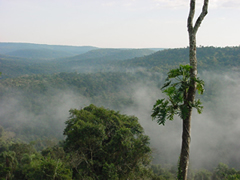 In our ethnobotanical research of the Guaraní we have quantified the importance of different plants to these people. Guembé comes third and is only surpassed in importance by a palm pindo (Arecastrum romanzoffianum) and the bamboo takuapi (Chusquea ramosissima). The Guaraní remain dependent on the resources of the forest around them and we have been studying this to promote the sustainable use and conservation of the forest. We found guembé to be an important source of edible fruit, fibre and medicine. Fortunately it appears to still be widespread and common in the forests of Misiones and so is a readily available resource. The annual flowering of guembé in the southern spring is a sign to the Guaraní that it is time to start planting their crops, because there will be no more frosts.
In our ethnobotanical research of the Guaraní we have quantified the importance of different plants to these people. Guembé comes third and is only surpassed in importance by a palm pindo (Arecastrum romanzoffianum) and the bamboo takuapi (Chusquea ramosissima). The Guaraní remain dependent on the resources of the forest around them and we have been studying this to promote the sustainable use and conservation of the forest. We found guembé to be an important source of edible fruit, fibre and medicine. Fortunately it appears to still be widespread and common in the forests of Misiones and so is a readily available resource. The annual flowering of guembé in the southern spring is a sign to the Guaraní that it is time to start planting their crops, because there will be no more frosts.
Fibre
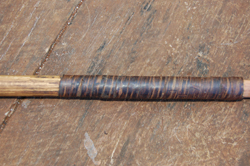 Perhaps the most important use of guembé is as a source of rope-like fibre that is extracted from the bark of the aerial roots which hang down from the plant. Guembé is an air plant, or epiphyte, that grows in the crotches of tree branches. The long thin cord-like roots hang down to the ground. The root bark is beaten out and dried to make an extremely strong cord that serves as a string for their bows. It is even strong enough to hold a peccary (wild pig) in a snare trap as we saw on a recent expedition. The rope also serves for many other uses in the daily lives of the Guaraní, such as tying together the various parts of their houses and to bind arrow points to the shaft (pictured). The inner part of the roots without the bark is used for making baskets, hats, and panniers for carrying loads on their backs. All in all guembé fibre is a most important commodity.
Perhaps the most important use of guembé is as a source of rope-like fibre that is extracted from the bark of the aerial roots which hang down from the plant. Guembé is an air plant, or epiphyte, that grows in the crotches of tree branches. The long thin cord-like roots hang down to the ground. The root bark is beaten out and dried to make an extremely strong cord that serves as a string for their bows. It is even strong enough to hold a peccary (wild pig) in a snare trap as we saw on a recent expedition. The rope also serves for many other uses in the daily lives of the Guaraní, such as tying together the various parts of their houses and to bind arrow points to the shaft (pictured). The inner part of the roots without the bark is used for making baskets, hats, and panniers for carrying loads on their backs. All in all guembé fibre is a most important commodity.
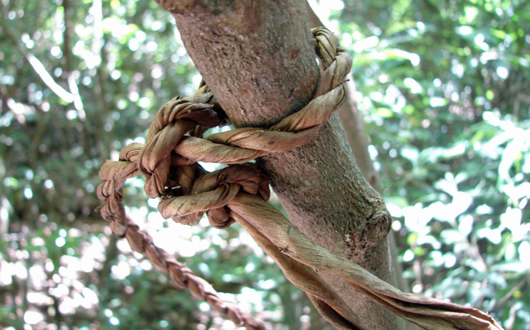
Guembe rope trap: this versatile rope is strong enough to hold even large animals.
Fruit
The fruits of several aroids are edible and perhaps the best known are those of the Swiss cheese plant, Monstera deliciosa. Guembé also has an edible fruit that is much appreciated by the Guaraní and is indeed pleasant tasting being reminiscent of bananas.
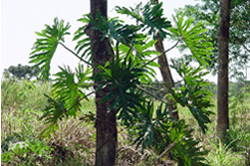 The fruits must only be eaten only when mature because, like all other parts of the plant, they contain crystals of calcium oxalate. Many people and also pets have suffered greatly, and even fatally, from eating parts of the other common aroid houseplant, Dieffenbachia, the dumb cane, which is also full of oxalate crystals. Eating it can completely block the airway and cause suffocation. However the mature fruits of guembé are delicious and cause no harm as long as you don’t eat the seeds. The Guaraní sometimes also eat the spathe or young inflorescence which they boil to eliminate the effect of the oxalates.
The fruits must only be eaten only when mature because, like all other parts of the plant, they contain crystals of calcium oxalate. Many people and also pets have suffered greatly, and even fatally, from eating parts of the other common aroid houseplant, Dieffenbachia, the dumb cane, which is also full of oxalate crystals. Eating it can completely block the airway and cause suffocation. However the mature fruits of guembé are delicious and cause no harm as long as you don’t eat the seeds. The Guaraní sometimes also eat the spathe or young inflorescence which they boil to eliminate the effect of the oxalates.
Repellent
A decoction of the leaves is made to spread in the houses to keep off fleas and biting insects. It is also used to treat the small burrowing fleas that enter the soles of feet.
Medicine and magic
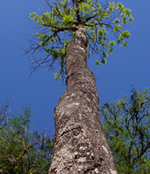 The sap that flows copiously from cut roots of guembé is used as a cicatrisant and coagulant on wounds, burns and snake bites. It is also used for toothache and conjunctivitis. A decoction from the roots is used to wash damaged hair to help it to grow back quickly and strongly. A decoction of the roots is used to treat intestinal pains and bloody diarrhoea.
The sap that flows copiously from cut roots of guembé is used as a cicatrisant and coagulant on wounds, burns and snake bites. It is also used for toothache and conjunctivitis. A decoction from the roots is used to wash damaged hair to help it to grow back quickly and strongly. A decoction of the roots is used to treat intestinal pains and bloody diarrhoea.
The inflorescence is also used ritually for the shamanistic ceremony of Ñemongarai that takes place in the spring when they carry out baptisms and marriages. The inflorescences are placed in the temple together with other symbolic elements such as honey and mate. Mate is a caffeine-rich leaf (Ilex paraguariensis pictured) that is used to make a tea used daily by the Guaraní. Tobacco smoke is blown over these objects as the shaman receives the messages he needs for the ritual such as the sacred and secret name of the children to be baptised or the health of the relatives of those to be married.